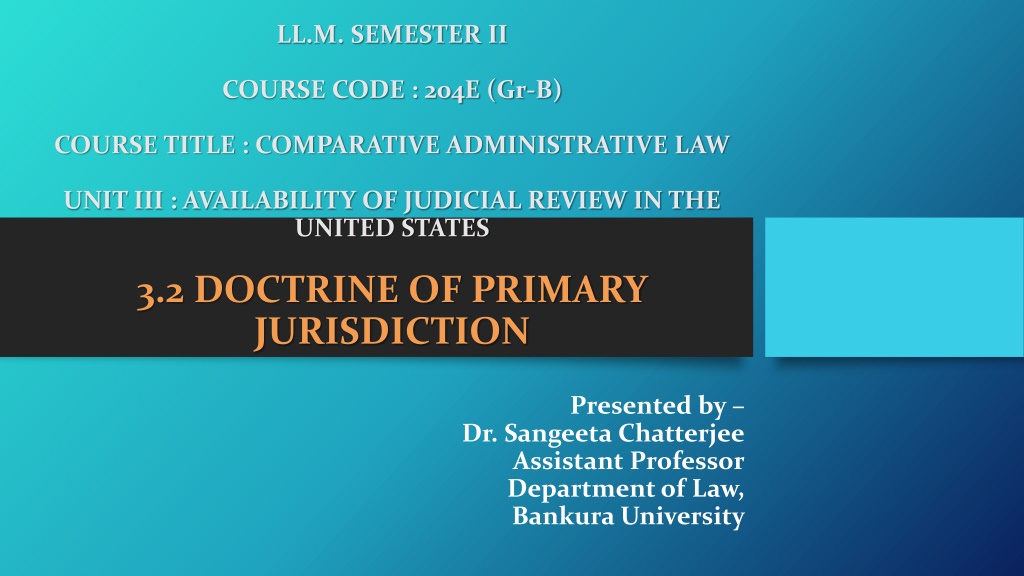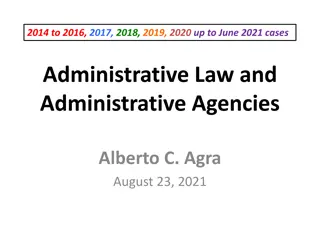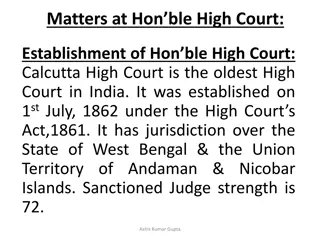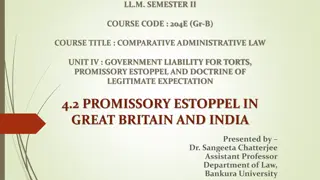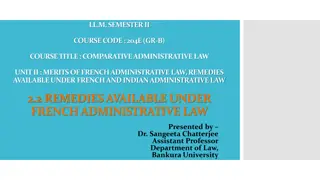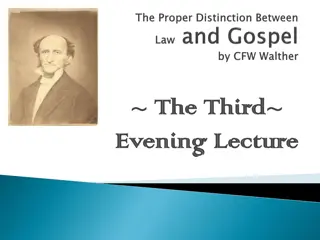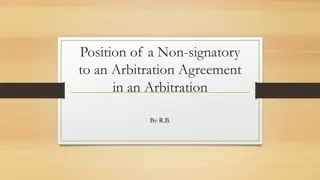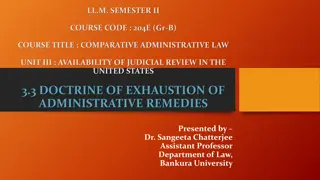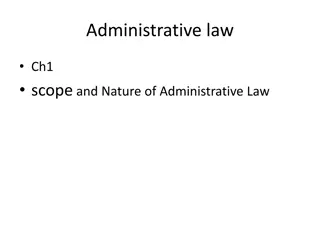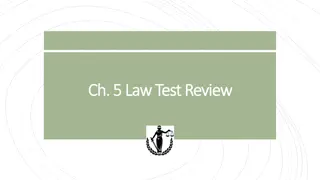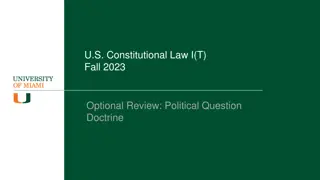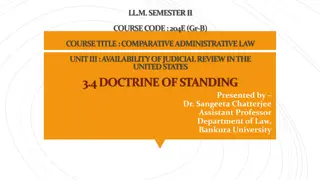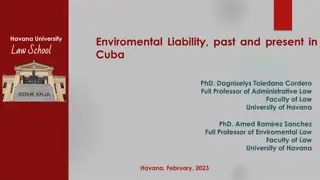Understanding Doctrine of Primary Jurisdiction in Comparative Administrative Law
The doctrine of primary jurisdiction plays a crucial role in determining whether a court should yield to an administrative agency for certain issues. It helps in deciding which tribunal should take the initial action, especially in cases involving administrative discretion. This doctrine allows courts to stay proceedings pending administrative determinations and emphasizes the importance of administrative expertise in specific subject matters.
Download Presentation

Please find below an Image/Link to download the presentation.
The content on the website is provided AS IS for your information and personal use only. It may not be sold, licensed, or shared on other websites without obtaining consent from the author. Download presentation by click this link. If you encounter any issues during the download, it is possible that the publisher has removed the file from their server.
E N D
Presentation Transcript
LL.M. SEMESTER II COURSE CODE : 204E (Gr-B) COURSE TITLE : COMPARATIVE ADMINISTRATIVE LAW UNIT III : AVAILABILITY OF JUDICIAL REVIEW IN THE UNITED STATES 3.2 DOCTRINE OF PRIMARY JURISDICTION Presented by Dr. Sangeeta Chatterjee Assistant Professor Department of Law, Bankura University
INTRODUCTION Within administrative agencies with adjudicatory power. Congress mayalsodefine the jurisdiction of Article III courts. As a result, Congress has the greatest control over the balanceof power between courts and agencies. It can provide exclusive jurisdiction over a matter to one tribunal, or provide concurrent jurisdiction to both. Neither courts nor agencies can disregard these statutory boundaries. constitutional limits, Congress may create
DOCTRINE OF PRIMARY JURISDICTION When a court wishes to defer to the adjudicatory authority of an agency, there are a numberof legal means available. Those are finality, ripeness, and exhaustion. A related but less popular means of deference is the primary jurisdiction doctrine. Because it is applied infrequently, the shape of this doctrine is not fully defined. Thecircuitcourts employ differing conceptions of primary jurisdiction. They utilize different factors in their analysis and apply different standards of review.
DOCTRINE OF PRIMARY JURISDICTION : THE CONCEPT Primary jurisdiction is the doctrine which might prompt a court to yield to an agency before deciding an issue. It provides that, in cases raising issues of fact not within the conventional experience of judges or requiring the exercise of administrative discretion, agencies created by Congress for regulating the subject matter involved should not be passed over.
DOCTRINE OF PRIMARY JURISDICTION : THE PURPOSE The purpose of this wholly judge-made doctrine is not to divide powers between courts and agencies but to determinewhich tribunal should take initial action. It means to decide between the appropriate tribunals. More specifically, in cases of administrative discretion, it determines which court or tribunal has the primary jurisdiction.
DOCTRINE OF PRIMARY JURISDICTION : EXPLANATION Thus, a court may have jurisdiction and yet stay its proceedings pending administrative determination of a particular issue or dismiss the case even though the eventual agency decision will be subject to judicial review. The reason being that, the court dealing with administrative determination has the primary jurisdiction. Owing to that reason, other jurisdictional courts may stay their proceedings ordismiss thecase.
REASONS FOR APPLICATION OF THE DOCTRINE The rationale for the application of the primary jurisdiction doctrine is traditionally expressed in terms of both the necessity for uniformity of application of a law and the need foradministrative expertise. Commentators agree that the doctrine is primarily applicable to controversies arising in the so-called regulated industries. Legislative intent, as implemented by a pervasive and systematic scheme of agency regulation is the factor prompting deference to administrative determination. The principal criterion for determining the applicability of primary jurisdiction is whether there is judicial need for resort to administrative judgment.
ORIGIN OF THE DOCTRINE The primary jurisdiction doctrine was first promulgated by the Supreme Court in Texas & Pacific Railway v. Abilene Cotton Oil Co., 204 U.S. 426 (1907). In that case, a shipper contended that a published carrier rate was unreasonable and sued the carrier in a state court for the excess. The Supreme Court held that only the Interstate Commerce Commission could determine whether the carrier rate was reasonable.
ORIGIN OF THE DOCTRINE Although jurisdiction in the agency and the courts, the Court reasoned that the purpose of the Act was to provide for uniform rates and that state court jurisdiction, without prior recourse to the agency, would render the Act unenforceable. Thus, the case creating the doctrine of primary jurisdiction did not mention agency expertise; rather, the Court sought to furtherthe uniform application of a federal statute. the Commerce Act provided for concurrent
CURRENT POSITION OF THE DOCTRINE The Tenth Circuit provided a thorough discussion of the primary jurisdiction doctrine. First stated that primary jurisdiction is a prudential doctrine arising in cases where Congress has placed an issue within the "special competence" of an agency. The doctrine serves two purposes, promoting both regulatory uniformity and resort to agency expertise, and it allows a court to stay judicial proceedings administrative action. pending appropriate
AIMS OF THE DOCTRINE The benefit to the court of an agency determination. The burden on the parties of withholding judicial relief. The need to maintain the proper working relationship between courts and agencies. The desire to avoid potential interference with an agency's performanceof its statutory responsibilities.
CRITICISM Most jurisdiction doctrine results from the manner in which the Court used the phrase, "primary jurisdiction," in Abilene Cotton and Merchants Elevator. In the context of those early cases, the Court actually meant jurisdiction when it said "jurisdiction." But over the course of the twentieth century, primary jurisdiction evolved into a doctrine that-for better or worse-has departed from the plain implication of its name. of the confusion surrounding the primary
CONCLUSION Today, primary jurisdiction does not define the actual scope of authority of courts or agencies. Rather, it allows a court to refrain from exercising its authority to further the objectives that the doctrine has now come to represent. Primary jurisdiction, as currently conceived, is a means of deciding which tribunal is the more advantageous decision-maker when the issue could be presented to either.
REFERENCE : 1. Aaron J . Lockwood, The Primary Jurisdiction Doctrine: Competing Standards of Appellate Review, Washington & Lee Law Review, Vol. 64, 2007. 2. Howard M. Boyd, Larry E. Christensen, Charles D. Ganz, David W. Hardee, Elisabeth S. Petersen and Wendell Schollander, Primary Jurisdiction and Its Subsequent Effect on Judicial Review, Duke Law Journal, Vol. 149, 1971.
